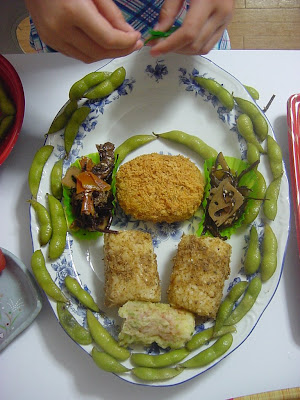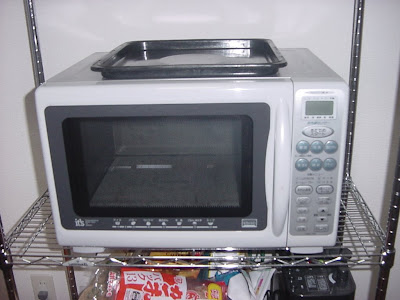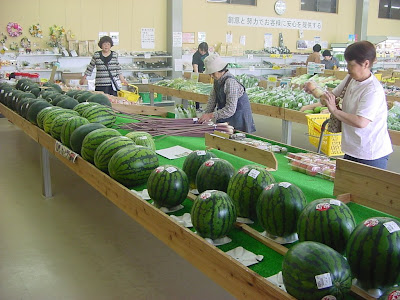Friday, July 31, 2009
Zaru dofu
Thursday, July 30, 2009
Wednesday, July 29, 2009
Tuesday, July 28, 2009
Monday, July 27, 2009
Update on prices
Saturday, July 25, 2009
Curry udon

Japanese curry (this is packaged, cooked, heat-n-serve curry) is mild even when it says spicy. This one says mild, so I guess it really is. Lee loves it, even when, as tonight, I add chopped cabbage to increase her vegetable intake for the day.
Curry probably first came to Japan with Indian cooks working for the foreign diplomatic and commercial missions in the late 19th century, but the usual story for the introduction of curry into Japan puts the date around the turn of the last century. Whenever it happened, it happened in the form of ultra-mild beef curry based on a French-style roux. I didn't like it even before I gave up eating mammals, but I keep some of these packages handy for Lee for those times I really want to eat something more interesting and really, really don't want to cook.
Curry udon is awfully Japanese, isn't it?
Thursday, July 23, 2009
Japanese versions
Japanese versions of foods from other countries are often different in very obvious ways (curry donuts, for instance), but sometimes the difference is more subtle. I like this comment, in a Japan Times cartoon.
Tofu -- theme and variations

I don't know how many different kinds of tofu there are, including the Stinky tofu we declined to eat in Taiwan, where it's a specialty. This morning I pulled these out of the fridge, three packages but basically two kinds. The two above are both "regular" tofu, kinugoshi, silken tofu. The one at the bottom with the colorful sticker is peanut tofu, which Yoshie buys sometimes as a treat for herself. It's basically kinugoshi with something added to give it a peanut flavor; I haven't yet found out what. I tried looking at the list of ingredients on this package, but it's covered by the brightly colored half-price sticker. It was half price because it was old. In fact, it was so old it was sort of turning into stinky tofu and, after Yoshie forced down one of the two little round cakes of tofu from the pack (she hates to waste food, especially food she's bought as a treat for herself), we threw out the other.
Tuesday, July 21, 2009
Monday, July 20, 2009
398 yen (about US $4.15)

- Rice
- Very small umeboshi (pickled plum)
- Shoga (pickled ginger)
- Macaroni salad (basically just pasta and mayonaise)
- Potato Salad (basically just potato and mayonaise)
- Spaghetti with tomato sauce
- Scrambled egg
- Parsley
- Mini-tomato (1)
- Red leaf lettuce
- Lemon slice
- Kamaboko (fish cake, 1 very thin slice)
- Breaded and fried strips of chicken breast
It sounds like a lot of food, though obviously it isn't. Yoshie loves this soft of meal. I don't, particularly, but it seemed like a good idea, especially since I needed lunch for Lee and Aiko as well. They picked out their own bento.
The inclusion of a really wide variety of foods is probably based, in part, on the Japanese nutritional teaching that, for health, you should eat at least 30 different kinds of food every day. That makes a certain amount of sense, doesn't it? The more different foods you eat, the more likely you are to get at least some of every nutrient you need.
Tuesday, July 14, 2009
Cold Tofu

One of my favorite dishes is one of the simplest -- ohiyakko -- cold tofu. In a restaurant it will usually be served with some katsuobushi on top. When I have it at home (several times a week), I just put on a dab of wasabi and a little soy sauce. Sometimes I'll substitute grated giner for the wasabi.
The wasabi I use is the regular supermarket wasabi from a tube. This is actually a mixture of Japanese wasabi, mustard, and (Western) horseradish with, I'm very sorry to say, green food coloring. The one listing I found for one kind of wasabi in a tube said it was 4.5% wasabi and 31.7% horseradish. I hope to find something better when I start shopping occasionally in a fancier store, maybe Sogo downtown. They must have the real thing.
Cooking
Saturday, July 11, 2009
Summer tomatoes

We've all been enjoying the fresh, true taste of summer tomates lately, especially when I've gotten local ones from our farmers' market, but this is ridiculous. Yesterday Yoshie and Lee visited one of Yoshie's aunts and came back with two big bags of fresh-picked tomatoes. We had tomatoes for dinner last night, breakfast and lunch today, and will have some more with the pasta al pesto I'll make for dinner with the basil they picked yesterday.
Next I'll have to figure out what do do with the cabbage, pumpkin, and other assorted vegetables they brought back with them. Yoshie had already made a stop at a farmers' market on Friday afternoon after work. Our refrigerator is STUFFED!
Thursday, July 9, 2009
Wiener sushi
I was just reading the WikiPedia article on sushi and noticed that it's somewhat out of date in one respect. Low-cost sushi restaurants, particularly the ones where every dish costs the same 100 yen (just over $1 US), make several kinds of sushi with cooked meat, particularly what has become one of Lee''s favorites -- wiener sushi. I hadn't run across the word wiener in a long time. Here it means, as it used to when I was a kid, a hot dog, a very small hot dog, like the ones sold in cans.
Wednesday, July 8, 2009
Cooking rice

As you can see, we have two electric rice cookers, but I've been using the pressure cooker since about our third day here and will probably continue to use it. It took me a few tries to get the proportions right, partly because we're using brown rice but washing it because it's from Yoshie's parents' supply (last year's rice, of course) and a few moths fluttered out when I first opened the bag. I've settled on two measuring cups of rice and three measuring cups of water plus 50cc after washing and draining the rice in a colinder. When the pressure top starts singing, I turn the heat down all the way, let it cook 35 minutes, then turn off the heat and let it sit on the stove until the pressure relief valve goes off.
According to the fascinating website What Japan Thinks, a recent survey showed that only 2% of Japanese households lack a rice cooker. Of course, as I said, we don't lack for rice cookers. It's just that I think the pressure cooker makes more sense nutritionally and also in turms of energy conservation. If I start working full-time one of these days, we'll probably start using one of the rice cookers since they can be programmed to have the rice newly-cooked and warm when you come home from the supermarket with the rest of dinner from the o-sozai department.
Also, Yoshie likes to bake cakes in them, though she hasn't been doing much baking since she started working full-time. (By the way, full-time in Japan typically means 50 - 60 hours a week and her job in definitely typical.)
We eat brown rice. In fact, at the moment, we don't have any white rice in the house, though that will soon change since we all prefer some dishes with mixed white and brown rice. I've spent quite a bit of time over the years trying to find out when white rice became the main form, but so far I haven't gotten any relevant information at all. Just as there's strong prejudice towards white bread in most of the world, white rice is generally considered by many people to be more pure, even more wholesome. When the oldest person in the world died a week or so ago, there were lots of articles in the Japanese press about how many centenarians there are in Japan. (Over 36,000 according to Wikipedia.) One article I read said this was generally attributed to the Japanese diet which, the writer said, was high in fish and white rice. One of the true characteristics of centenarians, cited in the Wikipedia article, is the fact the women who never marry were particularly likely to join the club.
California ramen!?????
Here's a link to an LA Times article on a restaurant that serves ramen that's not exactly traditional.
Monday, July 6, 2009
Lotus
Sunday, July 5, 2009
Traditional Japanese food

Soon afterI came to Japan to live in late 1990, I enjoyed a lunch that included コロッケ, korokke, which looked just like what you can see on my plate. The friend who had cooked the lunch asked me if I had ever had this particular Japanese dish before. She was surprized and, I think, disappointed to learn that I grew up on croquettes, which were pretty much the same thing and obviously both from the same French word. (I think it means crunch.)
Croquettes were introduced to Japan about 100 years ago and they're already accepted as "Japanese." Tempura has been in Japan for about four hundred years and it's pretty thoroughly integrated into the national cuisine, though its Portugese origin is widely remembered, at least in academic circles.
Of course, if you go back far enough, nearly all "Japanese" dishes can be traced back to Korea or China, even tofu, even rice. There's a strong feeling of trust in "Japanese" food, trust in its safety, purity, and health benefits. As I said about tofu last week, "Made in Japan," and with traditional Japanese ingredients, is a strong selling point.
There's even a tradition that "Japanese" food should always be eaten with chopsticks (though they too came from China) while "foreign" foods, even (sometimes) Chinese, can be eaten with a spoon or fork. When I taught at Yoshino Junior High School, I found that school lunch was served either with waribashi (throw away chopsticks) or sporks (the combination spoon and fork that used to be found sometimes in schools in the U.S.) depending on the perceived country of origin of the food. I remember complaining (humorously, I thought) to one of the other teachers that it was very hard to eat spaghetti with a spork, and thought the students should be given waribashi, as they were for udon, which are considered "Japanese" though they came from China too.
Saturday, July 4, 2009
Picnic food


We had a 4th of July picnic yesterday. I organized it and told everyone it was a picnic, I never used the word BBQ. Still, three of the other four families brought food to BBQ (beef, pork, fish, corn, eggplant) and two brought BBQs in traveling cases, which we didn't need because all four of the BBQ areas were empty when we got there at 4:30.
We were both busy in the morning, so we brought peanuts, raisins, cookies, and drinks and stopped by a supermarket for various makizushi. One of the other families did the same, though they also brought some yakitori and breaded chicken kushiyaki and one of the families that brought BBQ meat also brought homemade onigiri. It was delicious and easy, though, since this is Japan, we (mostly the Nakahara-sans) made sure the park's BBQ was just as clean when we left as when we arrived -- maybe cleaner.
Wednesday, July 1, 2009
More on tofu
Subscribe to:
Comments (Atom)
























